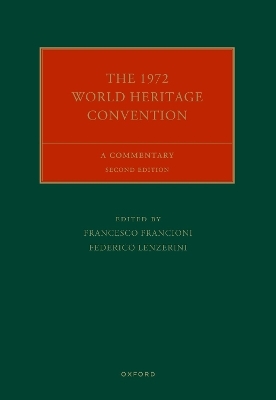
The 1972 World Heritage Convention
Oxford University Press (Verlag)
978-0-19-887744-8 (ISBN)
Almost fifty years have passed since the adoption of the Convention Concerning the Protection of the World Cultural and Natural Heritage (the UNESCO World Heritage Convention). With its 194 States Parties, it is the most widely ratified convention within the family of UNESCO treaties on the protection of cultural heritage. The success of this Convention and its almost universal acceptance by the international community of states is due to the great appeal that recognising certain properties as “world heritage” has for national governments.
Since the publication of the first Commentary, new problems have arisen in the management of world heritage sites. It has become increasingly difficult to properly monitor the conservation of the ever-growing mass of sites inscribed in the World Heritage List, and to resolve disputes over the formal designation of contested world heritage properties - a problem that has led to the withdrawal of the United States and Israel from UNESCO. New frontiers are now being explored for the expansion of the world heritage idea over marine areas beyond national jurisdiction, and the monopoly of the State in the identification, delineation, and presentation of world heritage properties is being increasingly challenged in the name of indigenous peoples' rights and by local communities claiming ownership over contested cultural sites. At the same time, the regime of world heritage protection has infiltrated other areas of international law, especially international economic law, investment arbitration, and the area of international criminal law. This second edition critically examines the World Heritage Convention against this dynamic evolution of international heritage law to help academics, lawyers, diplomats, and officials interpret and apply the norms of the Convention after half a century of uninterrupted implementing practice by State Parties and Treaty Bodies.
Francesco Francioni is Professor Emeritus of International Law at the European University Institute. He has published extensively in the field of international law and held the Chair of International Law at the University of Siena from 1980 to 2003. He was a visiting professor at the University of Texas, Austin, from 1987 to 2008 and has taught as a visiting professor at the Universities of Cornell, Oxford , Munich, and Columbia, NY. He is a legal consultant for UNESCO and has participated in the negotiation of the main treaties and protocols concerning the protection of cultural heritage of the past 25 years. In 1987 and 1988 he was President of the UNESCO World Heritage Committee. Federico Lenzerini is Professor of international law and European Union law for the Faculty of Law of the University of Siena. He is a consultant of UNESCO for the Department for the Protection of Cultural Heritage and the Legal Counsel of the Ministry of Foreign Affairs for international negotiations relative to the protection of cultural property. He is a member of the "Italian International Law Society " and the "Biotechnology Committee" of the International Law Association. His relevant areas of research are human rights protection, the right to asylum (under the double profile of general international law and of community law), rights of indigenous populations (according to comparative and international law), International Business and Trade Law, the international protection of cultural heritage, and cultural diversity.
PART I. INTRODUCTION
Francesco Francioni: The 1972 World Heritage Convention: An Introduction
Christina Cameron: Conceptual Developments of the World Heritage Convention
PART II. COMMENTARY
Francesco Francioni: The Preamble
Abdulqawi A. Yusuf: Article 1 Definition of Cultural Heritage
Amy Strecker: Article 1 Cultural Landscapes
Catherine Redgwell: Article 2 Definition of Natural Heritage
Ben Boer: Article 3 Identification and Delineation of World Heritage Properties
Guido Carducci: Articles 4-7 National and International Protection of the Cultural and Natural Heritage
Tullio Scovazzi: Articles 8-11 World Heritage Committee and World Heritage List
Gionata P. Buzzini and Luigi Condorelli: Article 11 List of World Heritage in Danger and Deletion of a Property from the World Heritage List
Federico Lenzerini: Article 12 Protection of Properties Not Inscribed on the World Heritage List
Ana Filipa Vrdoljak: Article 13 World Heritage Committee and International Assistance
Ana Filipa Vrdoljak: Article 14 The Secretariat and Support of the World Heritage Committee
Federico Lenzerini: Articles 15-18 World Heritage Fund
Federico Lenzerini: Articles 19-26 International Assistance
Federico Lenzerini: Articles 27-28 Educational Programmes
Ben Boer: Article 29 Reports
Ben Boer: Article 34 Federal or Non-Unitary Constitutional Systems
Federico Lenzerini: Articles 30-33 and 35-38 Final Clauses
PART III. RELATION OF THE WORLD HERITAGE CONVENTION WITH OTHER RELEVANT INTERNATIONAL REGIMES
Guido Carducci: The 1972 World Heritage Convention in the Framework of Other UNESCO Conventions and Other Instruments on Cultural Heritage
Catherine Redgwell: The World Heritage Convention and Other Conventions Relating to the Protection of the Natural Heritage
Ana Filipa Vrdoljak: World Heritage and Human Rights
Federico Lenzerini and Dalee Sambo Dorough: The World Heritage Convention and the Rights of Indigenous Peoples
Patrizia Vigni: The World Heritage Convention and the Law of the Sea
Valentina Vadi: The World Heritage Convention and International Investment Law
PART IV. CONCLUSIONS
Francesco Francioni and Federico Lenzerini: The Future of the World Heritage Convention: Problems and Prospects
| Erscheinungsdatum | 19.10.2023 |
|---|---|
| Reihe/Serie | Oxford Commentaries on International Cultural Heritage Law |
| Verlagsort | Oxford |
| Sprache | englisch |
| Maße | 175 x 252 mm |
| Gewicht | 980 g |
| Themenwelt | Recht / Steuern ► EU / Internationales Recht |
| Recht / Steuern ► Öffentliches Recht ► Völkerrecht | |
| Sozialwissenschaften ► Politik / Verwaltung ► Europäische / Internationale Politik | |
| ISBN-10 | 0-19-887744-7 / 0198877447 |
| ISBN-13 | 978-0-19-887744-8 / 9780198877448 |
| Zustand | Neuware |
| Informationen gemäß Produktsicherheitsverordnung (GPSR) | |
| Haben Sie eine Frage zum Produkt? |
aus dem Bereich


